For the first time in 24 years, and for only the second time in their history, Slovenia have qualified for the European Championships.
Under Matjaž Kek, Slovenia qualified directly to the tournament from their group, finishing second behind group winners Denmark.
This direct qualification was the first time the nation qualified without needing to go to a playoff, as was the case in their previous Euros campaign, as well as their only two World Cup finals.
Slovenia have never made it past the group stages in any of their other three tournament appearances but look to change the narrative this time around, with Atlético Madrid goalkeeper and captain Jan Oblak, as well as 20-year-old hotshot striker Benjamin Šeśko, two of the most notable players in a Slovenian squad that will look to cause some upsets in Group C.
Predicted starting XI
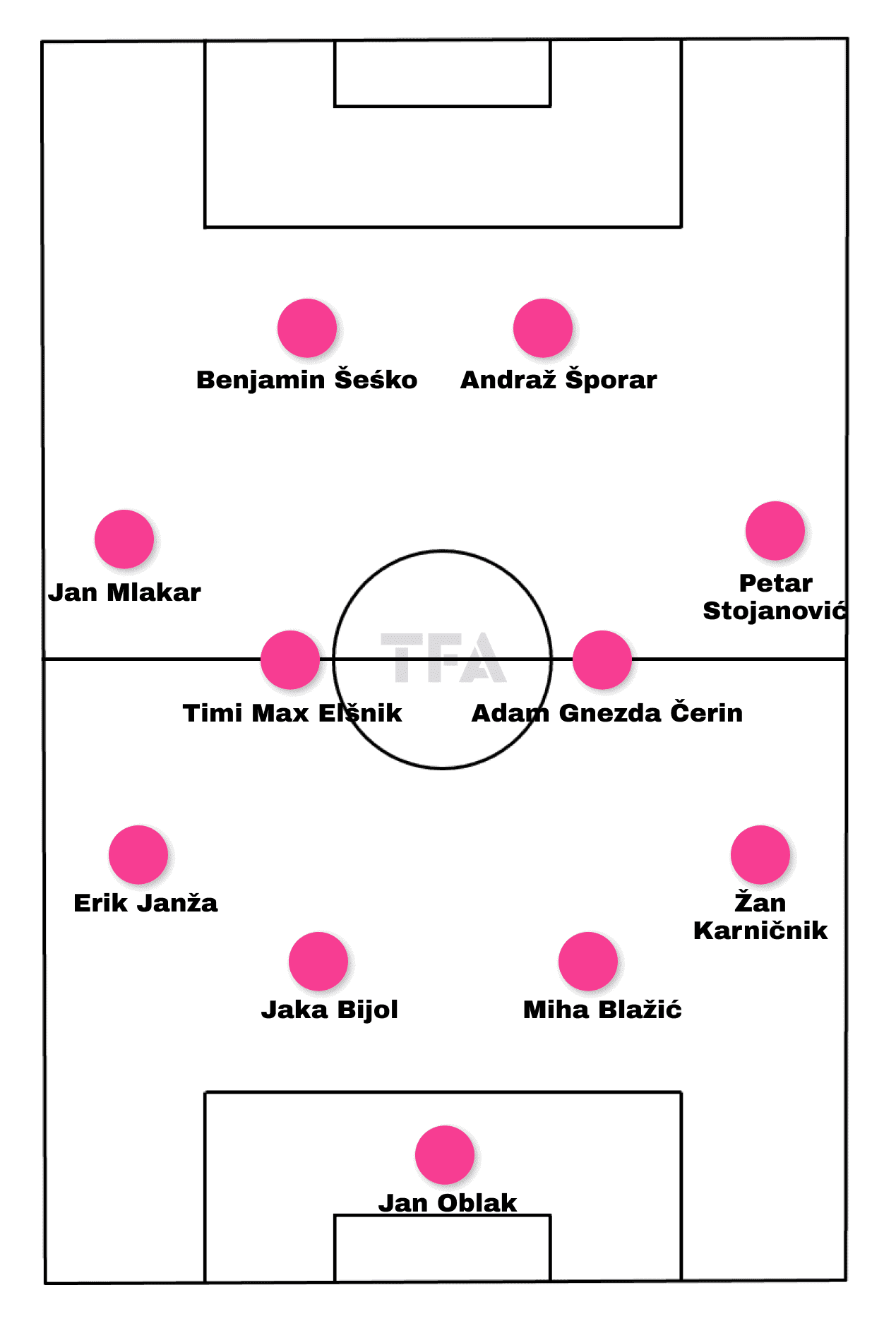
Throughout their entire qualifying campaign for this tournament, Matjaž Kek opted to set Slovenia up in a traditional flat 4-4-2 formation, with this very likely to continue to be the case when the tournament gets underway in the middle of June.
Slovenia will look for their full-backs to push forward in attacking phases of play, with them typically finding themselves in the attacking half of the pitch when they are in possession.
They sometimes will favour a direct route from the goalkeeper and backline but will also look to play with the ball a bit, with the forwards and wide midfielders occasionally interchanging positions and finding themselves in deeper positions to gather possession.
Jan Oblak will be Kek’s first-choice goalkeeper.
The Atlético Madrid player is the national team captain and one of their standout performers during their Euro 2024 qualifying campaign.
While there has been some rotation in the back four during their recent international break with friendlies against Malta and Portugal, this will be the most likely back four deployed by Matjaž Kek.
30-year-old Erik Janža looks set to get the nod at left-back, with Žan Karničnik likely being deployed at right-back.
Alanyaspor’s Jure Balkovec can offer depth in the full-back positions for Slovenia, with the 29-year-old starting at left-back in their recent friendly draw against Malta.
In central defence, 25-year-old Udinese defender Jaka Bijol will likely start alongside Miha Blažić.
25-year-old David Brekalo can also be an option for Slovenia in central defence, with the Orlando City centre-back adjusting well to MLS and becoming a starter before a recent minor injury.
24-year-old Vanja Drkušić could also offer some depth in the centre-back positions but is unlikely to have a starting role at this summer’s tournament.
Moving into the midfield and the central areas, Kek has had the most reliability and consistency during the qualifying campaign.
Both Olimpija Ljubljana’s Timi Max Elšnik and Panathinaikos’s Adam Gnezda Čerin have been cogs in the midfield for Slovenia, with both players capable of being the links between the defence and forward line while also being able to contribute from a defensive standpoint.
Kek will likely also have plenty of options for rotation in the central areas as the match gets into the final stages, with Jon Gorenc-Stanković and Jasmin Kurtić two likely players who come off the bench and contribute.
In the wide midfield areas, Pisa’s Jan Mlakar looks set to occupy the left side of midfield, while hybrid midfielder/defender Petar Stojanović will likely start on the right.
Udinese’s Sandi Lovrić offers depth out wide, as does 30-year-old Benjamin Verbić, with both players looking likely to be impact substitutes off the bench.
Advancing to the forward line, and this is where there is a lot of excitement for Slovenians.
Starting up top will be 20-year-old RB Leipzig forward Benjamin Šeško, with the exciting young talent Slovenia’s top scorer from the Euro 2024 qualifying campaign, with five goals from his nine matches.
He also has already scored 11 goals for his country in only 28 caps, with Šeško, the player opposing defences, will have to try and keep under control due to his ability both on and off the ball.
Partnering Šeško up top will likely be 30-year-old Panathinaikos forward Andraž Šporar, but Kek will have a few options to call upon off the bench once the group stages kick-off.
FC Lugano forward Žan Celar is one of those, with the 25-year-old a player who has often come off the bench for Kek in both Euro qualifiers and friendly matches.
Kek does not tend to take both starting forwards off in the same game, so opportunities may be limited for others, but some other forwards to keep an eye on for Slovenia are Bodø/Glimt striker Nino Žugelj and Bordeaux striker Žan Vipotnik.
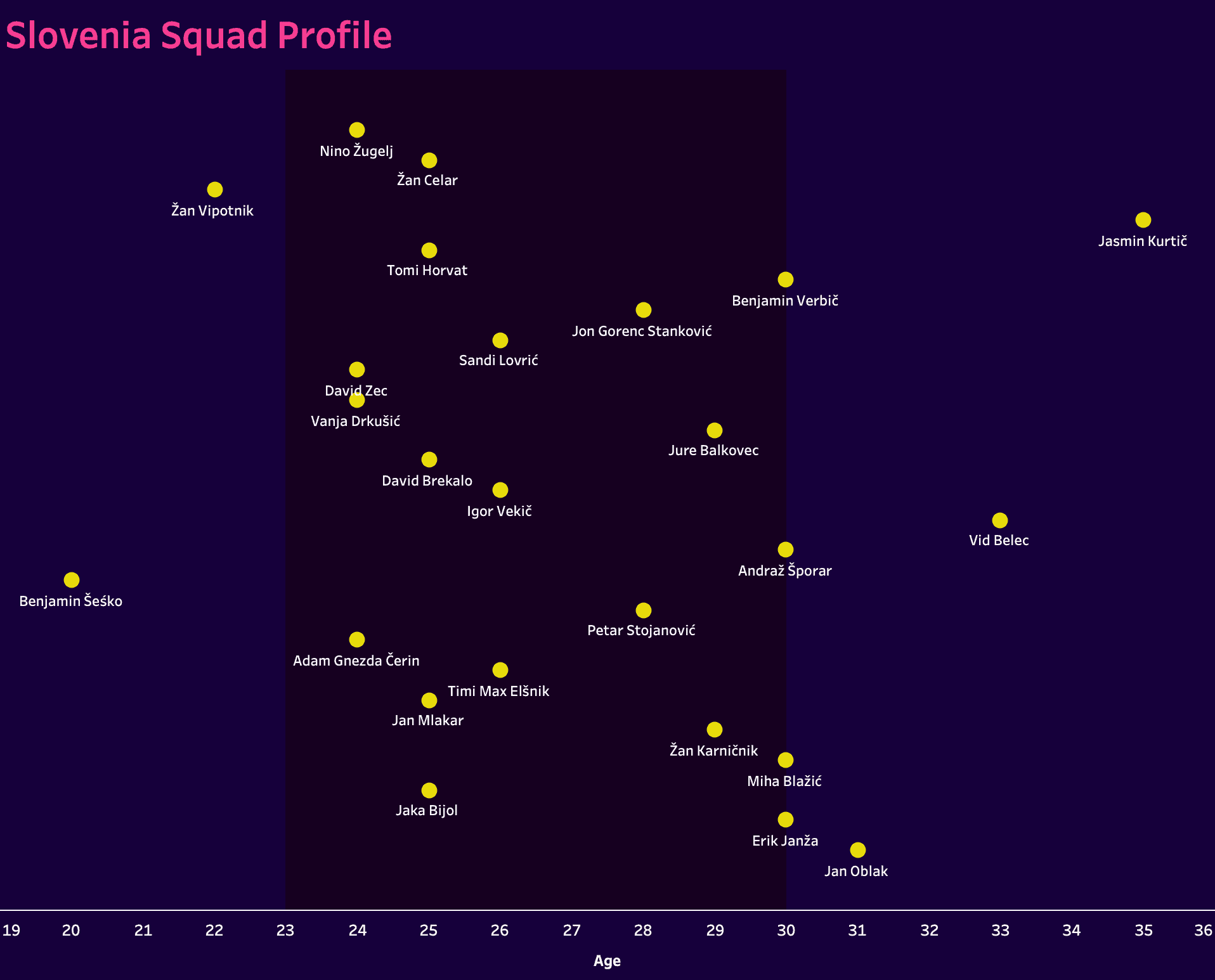
As we can see from the squad depth graphic above, most of the predicted Slovenian squad are in the primes of their career, with only a few of the squad under 23 or over 30.
Also, the players sitting on either far end of the age range will likely be playing valuable roles for Slovenia in this tournament.
Jan Oblak is the national team captain and one of the top goalkeepers in world football, while Jasmin Kurtić offers a veteran presence and leadership off the bench for Matjaž Kek.
On the younger side, Benjamin Šeško will be Slovenia’s key player and most likely source of goals this summer, while Žan Vipotnik offers some goalscoring capabilities off the bench.
Attacking phase
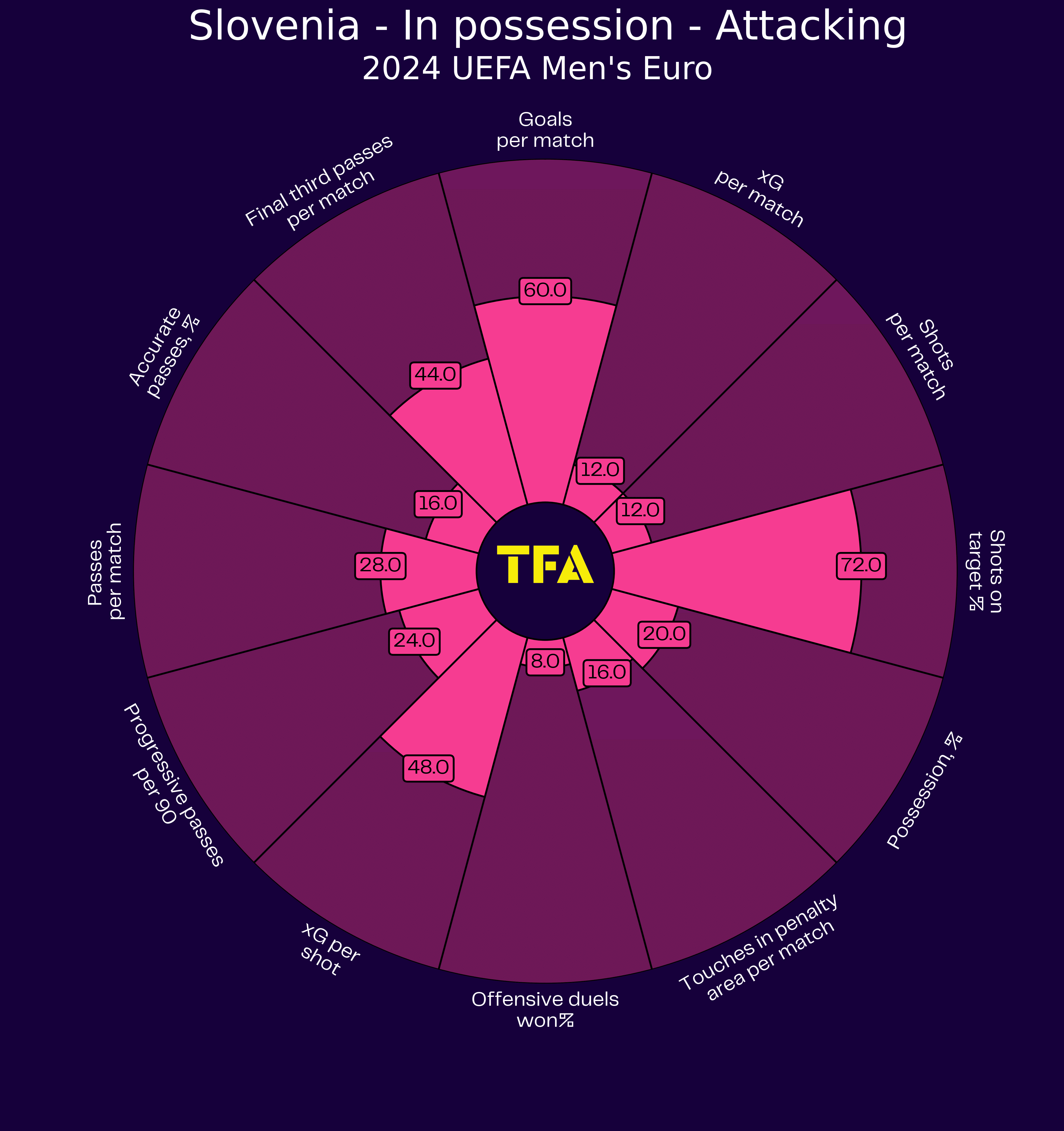
As we can see from the pie chart graphic above, Slovenia does not rank highly in the possession percentage per match or total number of passes, which highlights that Kek’s side often tends to be more direct in possession.
However, they will sometimes look to hold possession throughout matches and build with their backline and midfield before opting to go a more direct route.
Slovenia do rank relatively highly in shots on target % and goals per match, with Slovenia always a threat to score when they are able to reach the final third of the pitch.
When looking at how Slovenia looks to set up when they are in possession and on the attack, you begin to notice a well-defined possession shape.
While the full-backs look to get advanced into the attacking half of the pitch, they don’t get super advanced, with the wide midfielder looking to hold the width in the attacking third and join the two strikers, with the shape almost tending to look like a 4-2-4 in attack.
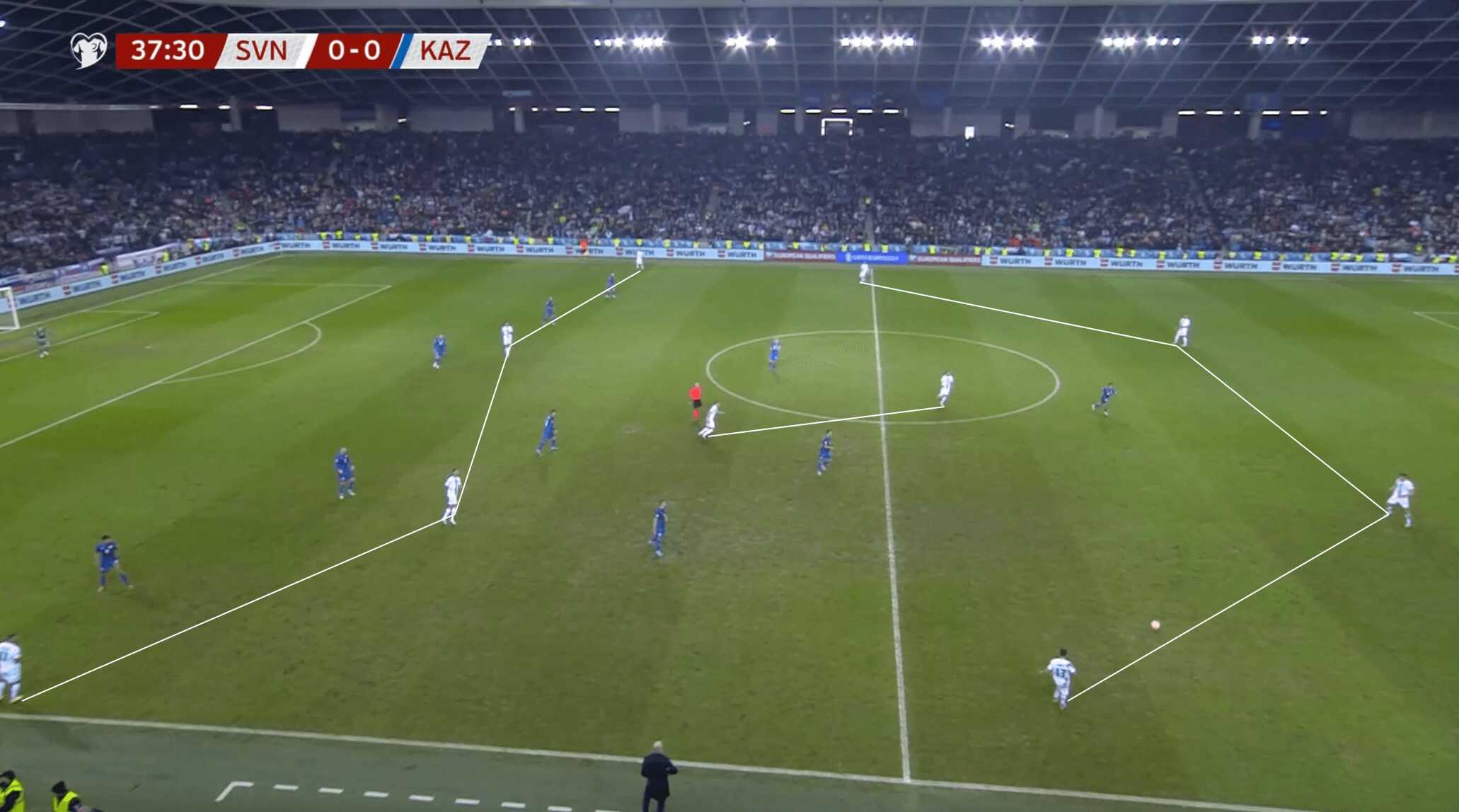
When looking at the pie chart, we can see that Slovenia is a side that can be a bit of a mixed bag at times when it comes to their ability and desire to hold possession.
In games where they have less quality than their opposition, Matjaž Kek will look to set his side up in a more defensive approach and look to hit the opposition in transitional moments.
However, against weaker opposition, Slovenia have tended to opt for a more possession-oriented approach, as was the case in their recent Euro qualifier against Kazakhstan.
In the image above, we can see the expansive shape that Slovenia morphs into when they look to possess the ball instead of being more direct.
Kek’s side begins to look like more of a 4-2-4, with them looking to attack the wide areas.
The central midfielders become staggered, operating on different lines to look to create multiple passing angles—the back four look to get expansive while the two wide midfielders hug the touchline.
The two strikers look to be active off the ball, either making runs beyond the backline to be found with long balls over the top or dropping into midfield to be options between the lines in pockets of space.
The Slovenian strikers are never stagnant; they are always creating angles and looking for the ball.
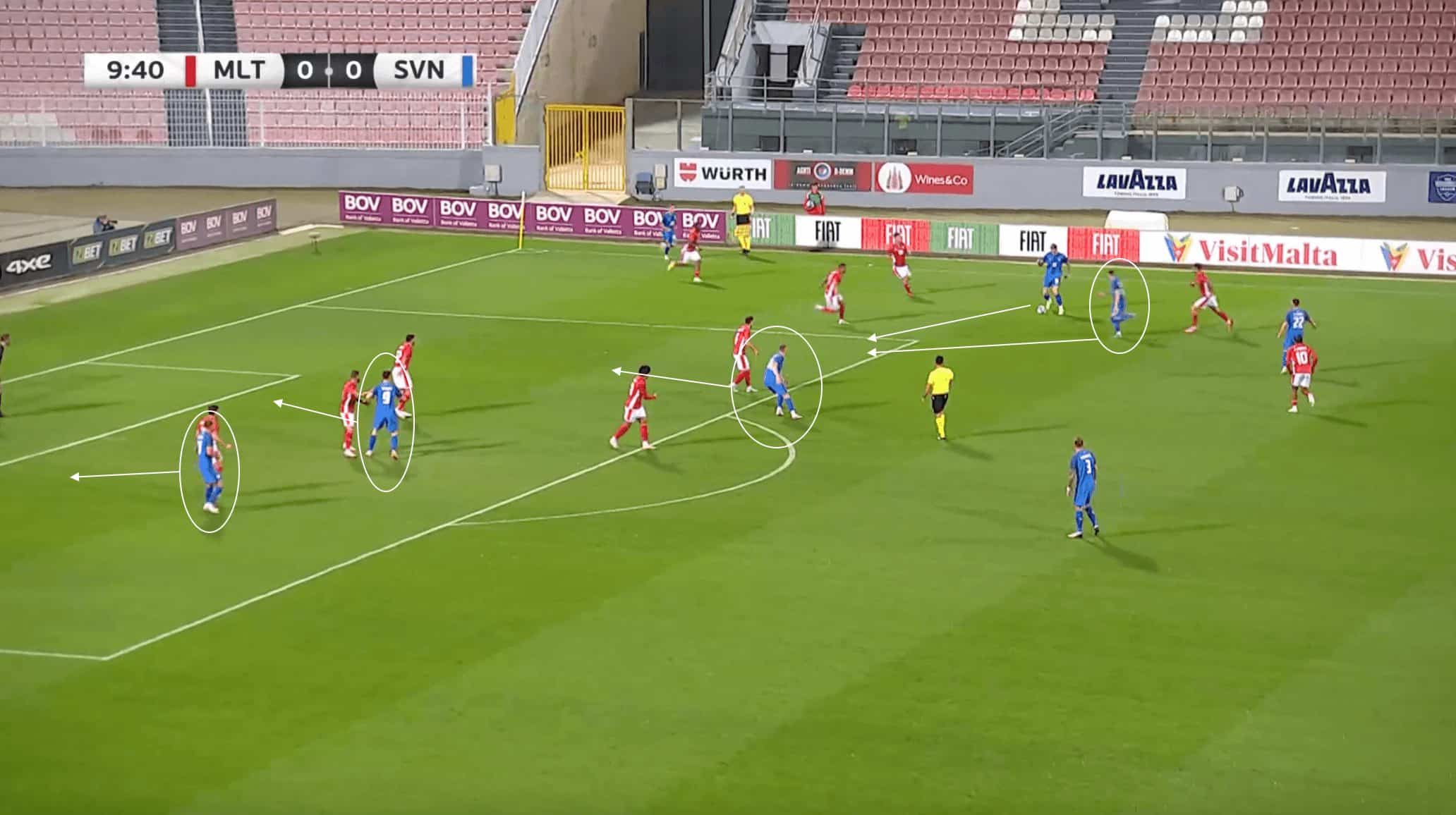
Something that the pie chart graphic above does not show is how Slovenia look to attack once they progress the ball into the final third.
Under Matjaž Kek, Slovenia have looked to prioritise progressing the ball through the wide channels once reaching the final third, with them looking to have numbers in the box centrally attempting to get onto the end of passes across the face of goal.
A good example of this is shown above from Slovenia’s recent friendly draw with Malta.
There is plenty of positional interchange between the attacking players, with Šeško finding himself in the wide channel in possession.
He then plays a pass into the path of the underlapping wide midfielder, who is able to drive into the box and play a ball across goal towards the runners.
Slovenia have also managed to create good goalscoring chances off of these attacking moments, though they do not happen often, as Slovenia rank in the 12th percentile for both shots per game and xG per shot.
Therefore, Slovenia are a side that may not create many goalscoring chances in attacking phases, but when they do get their opportunities on goal, they usually tend to be clinical.
Defensive phase
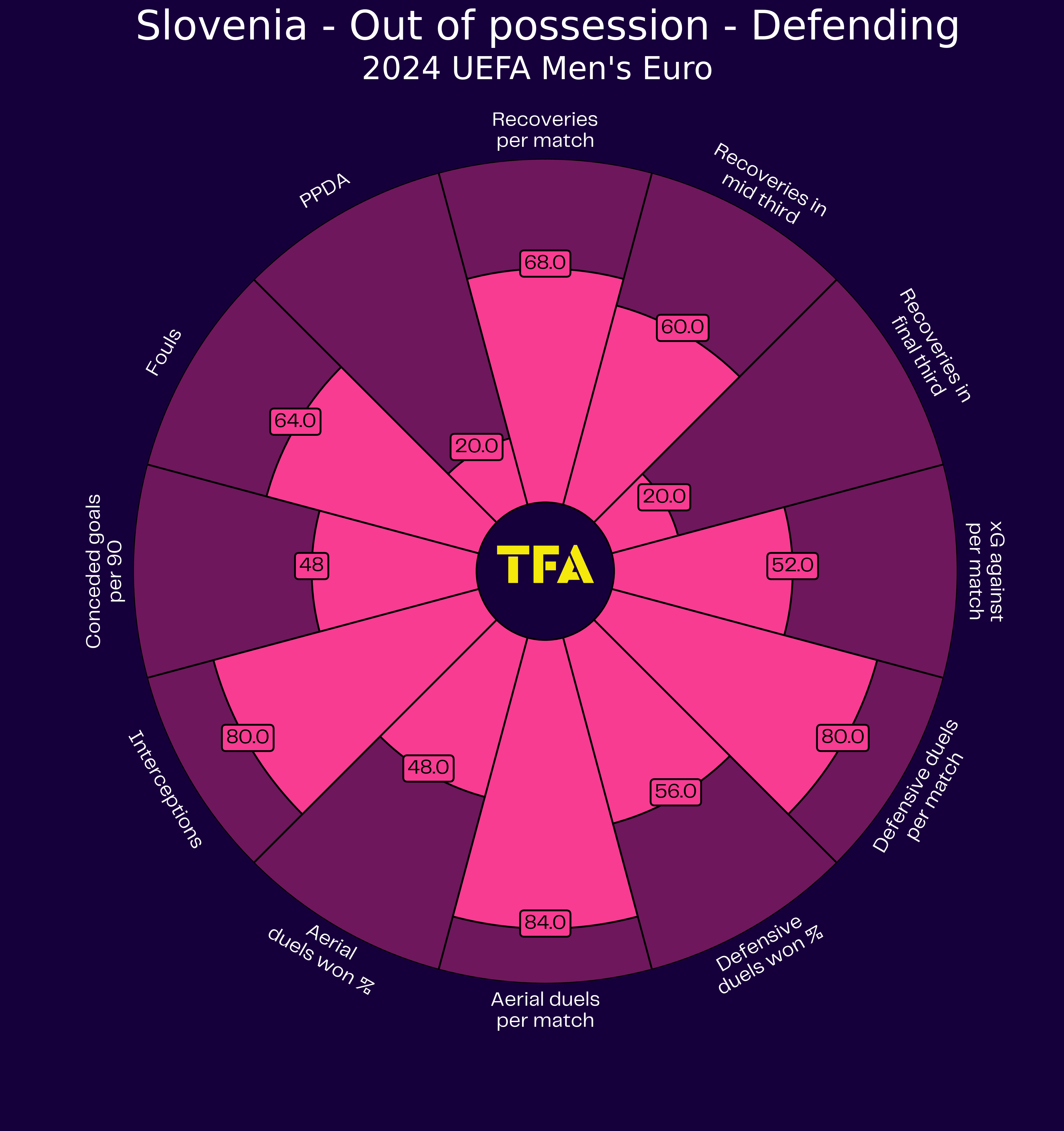
From a defensive standpoint, Slovenia are a side that does not put much pressure on opposition sides when they are in possession and looking to build out from the back.
Their PPDA ranks in the 20th percentile of nations in the Euros, as well as their low percentile rank regarding recoveries in the final third, highlighting their tendency to instead sit off in either a mid or low block defensive shape.
They rank highly in defensive duels per match, aerial duels per match, and interceptions per match, with Slovenia banking on being defensively solid when the opposition are able to progress the ball into their defensive half of the pitch.
They have been a bit hit-and-miss from a defensive standpoint in their recent matches, but a clean sheet against one of the tournament favourites in Portugal was very impressive.
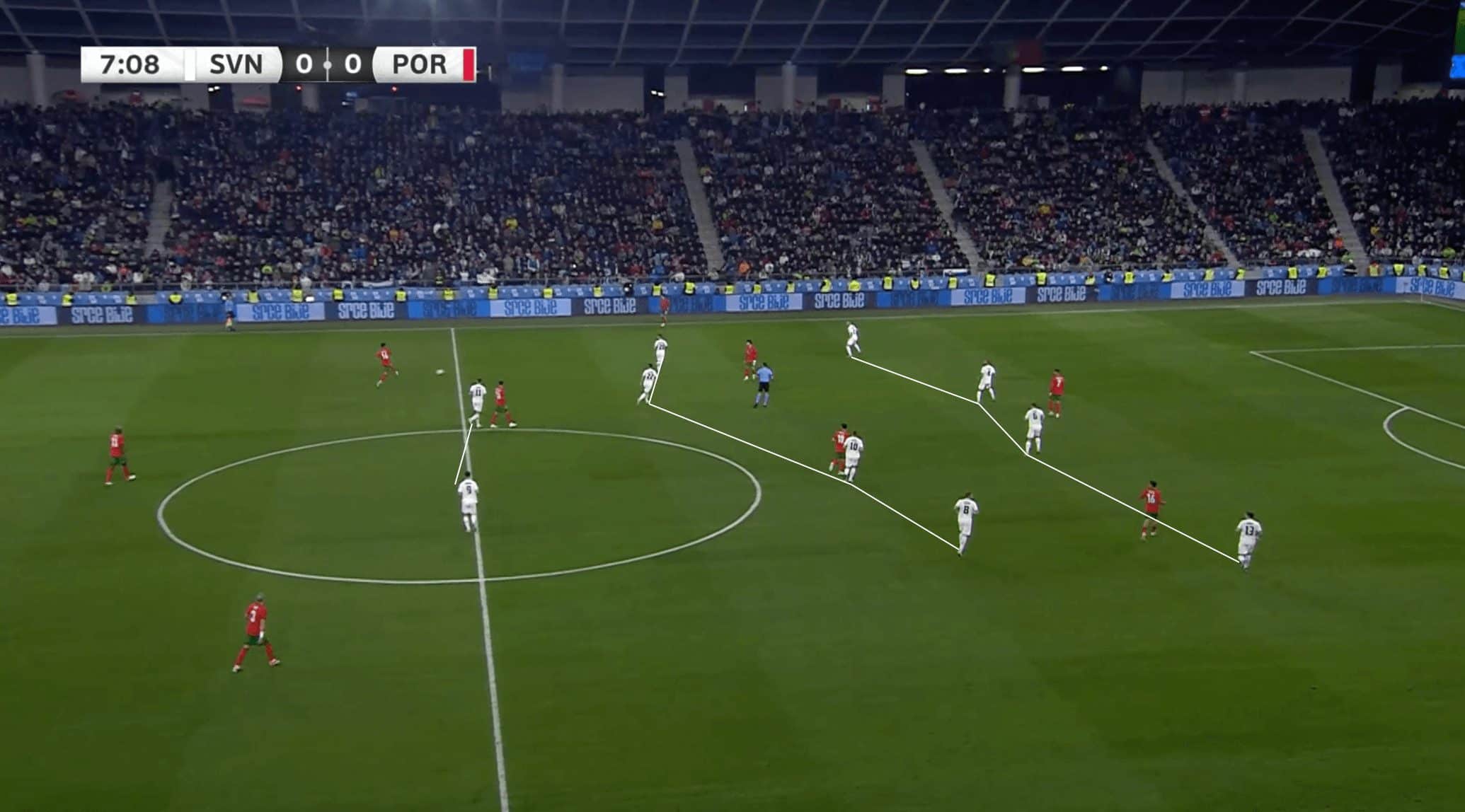
One of the reasons behind Slovenia’s usually solid defensive shape is the mid to low block that they operate in during defensive phases of play.
As we can see from this example against Portugal, Kek’s side are sitting in a narrow and compact 4-4-2 shape off the ball, looking to eliminate central ball progression and force the opposition to play the ball into the wide areas.
Once the ball is forced into the wide areas, Slovenia ideally look to keep it there, but when it comes to their mid-block defending, they will not look to be aggressive; they will allow the opponent to switch the play to the opposite side.
In this mid-block defensive shape, the goal from Slovenia is to eventually force the opposition to play the ball long towards their forwards, with the Slovenian defenders then tasked with winning aerial duels and regaining possession.
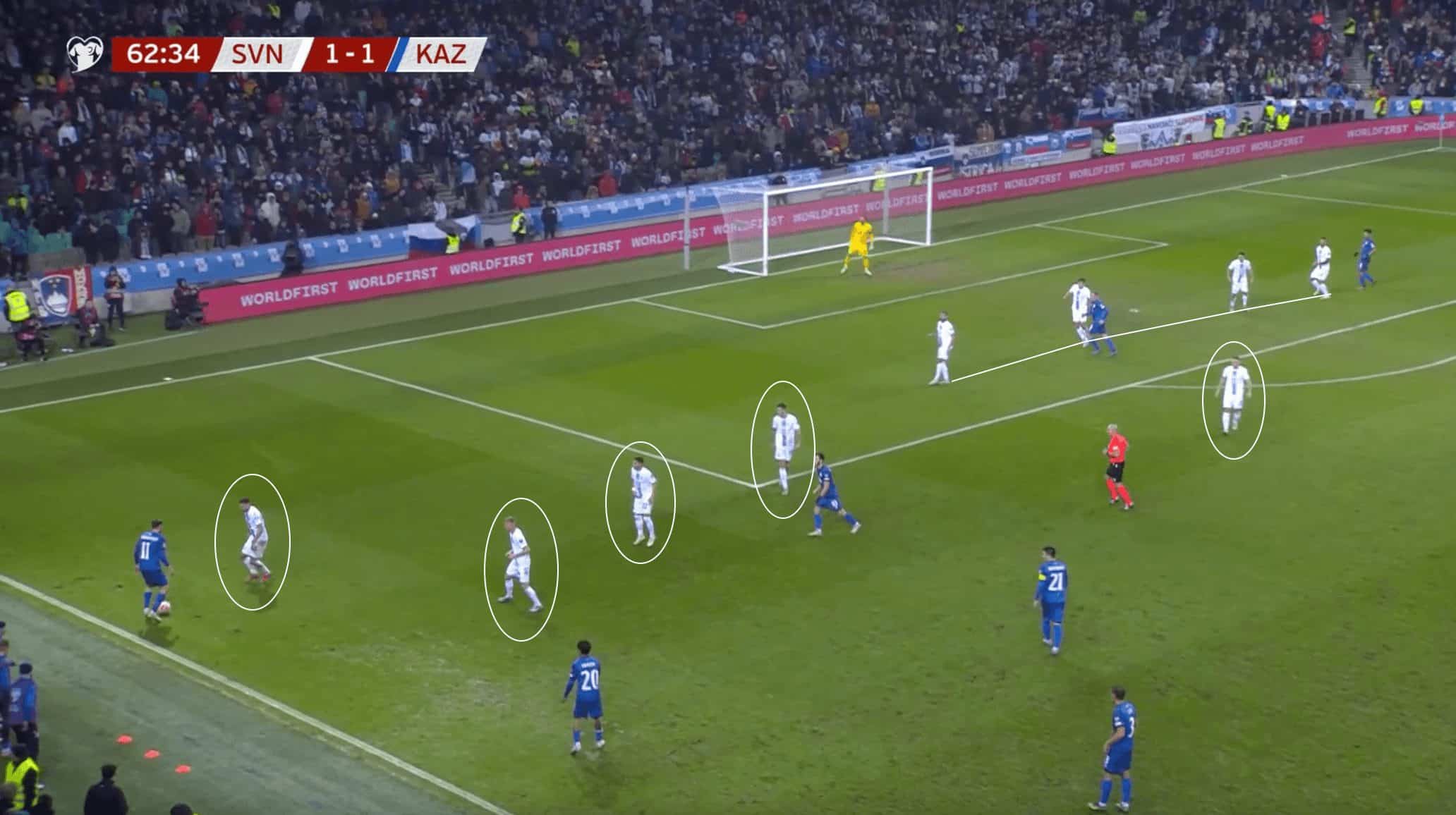
Slovenia have also looked to be defensively solid when they are forced to defend in a low block.
In this Euro qualifying match against Kazakhstan, we can see that nine of the ten Slovenia outfield players are almost sitting behind the ball, with the back four staying compact and narrow inside the penalty box, looking to protect the area between the posts.
Slovenia will likely be on the back foot throughout the majority of their time in this tournament, so they will need to continue being solid defensively, whether that is in their mid-block 4-4-2 shape or putting almost all their numbers behind the ball and being compact and narrow in their low block shape.
Transitions
While Slovenia will still look to possess the ball and take the game to their group-stage opponents this summer, they are likely going to be on the back foot often in this tournament; transitional moments will be essential for them to try and catch opposition sides on the break when possession is turned over.
With the ball progression capabilities of the midfielders, as well as pace and physicality Slovenia will have up top with Šeško and Šporar, Slovenia may need to be very clinical in this phase of play to catch opposition defences out.
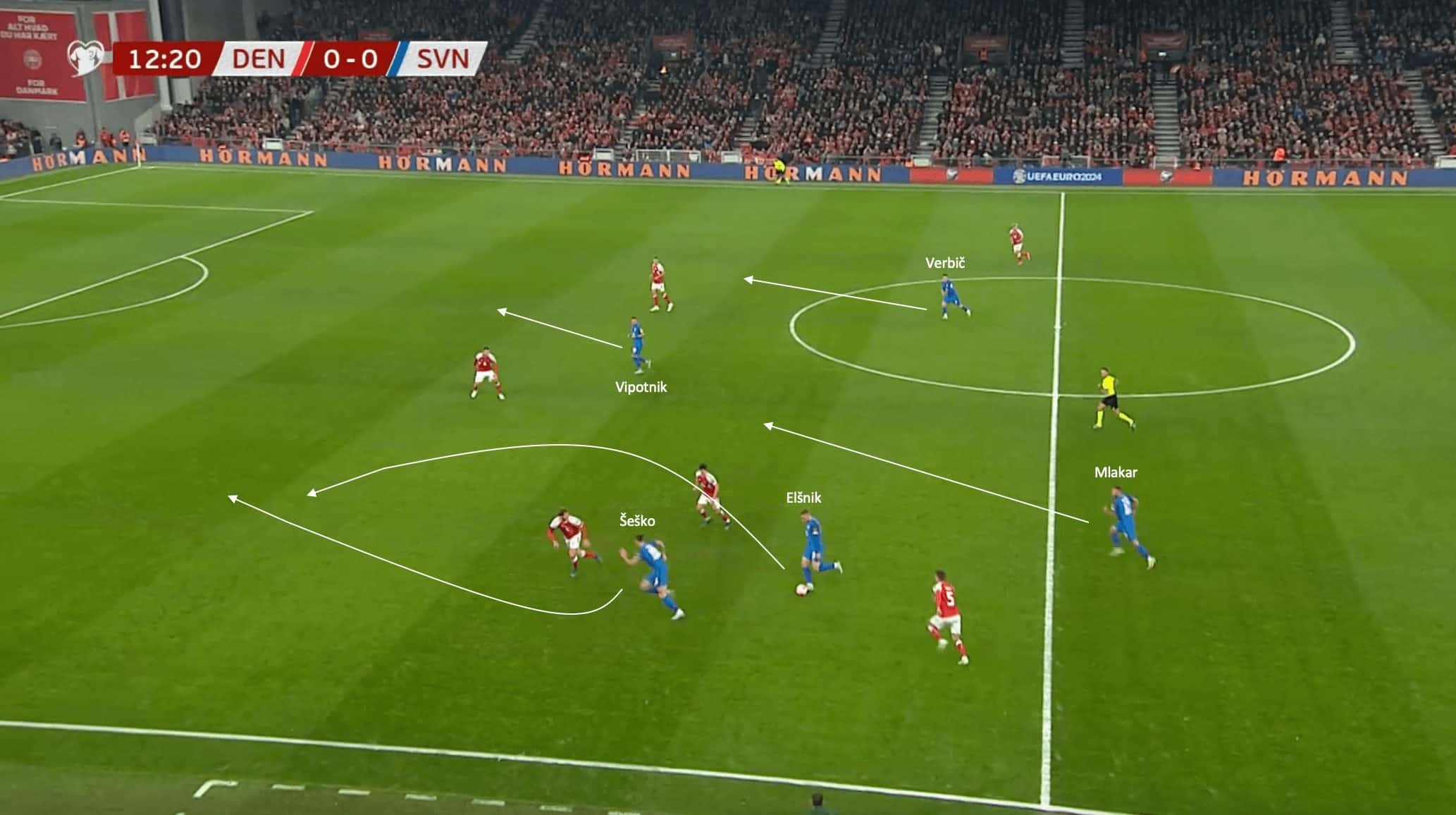
The image above shows an example of how dangerous Slovenia can be in transitional moments.
In this phase of play against Denmark in their Euro 2024 qualifying campaign, this transitional moment comes right after a Denmark shot is parried away by Oblak.
The ball is quickly sent forward, with Elšnik able to use his aggressiveness to win the ball back after it falls to a Danish player.
Šeško finds himself out in the wide channel, with Elšnik playing a chipped ball in behind the defender for the 20-year-old striker to run onto.
As the forward runs onto the ball and drives towards the penalty area, Elšnik, Mlakar, Vipotnik and Verbič all get on their horses and make driving runs into the penalty area to support Šeško.
His cross is sent towards Vipotnik, who made a run toward the back post area, but it is cleared away by a Denmark defender, allowing Slovenia a throw-in deep inside the Danish half, with this phase originating from a great save by Jan Oblak.
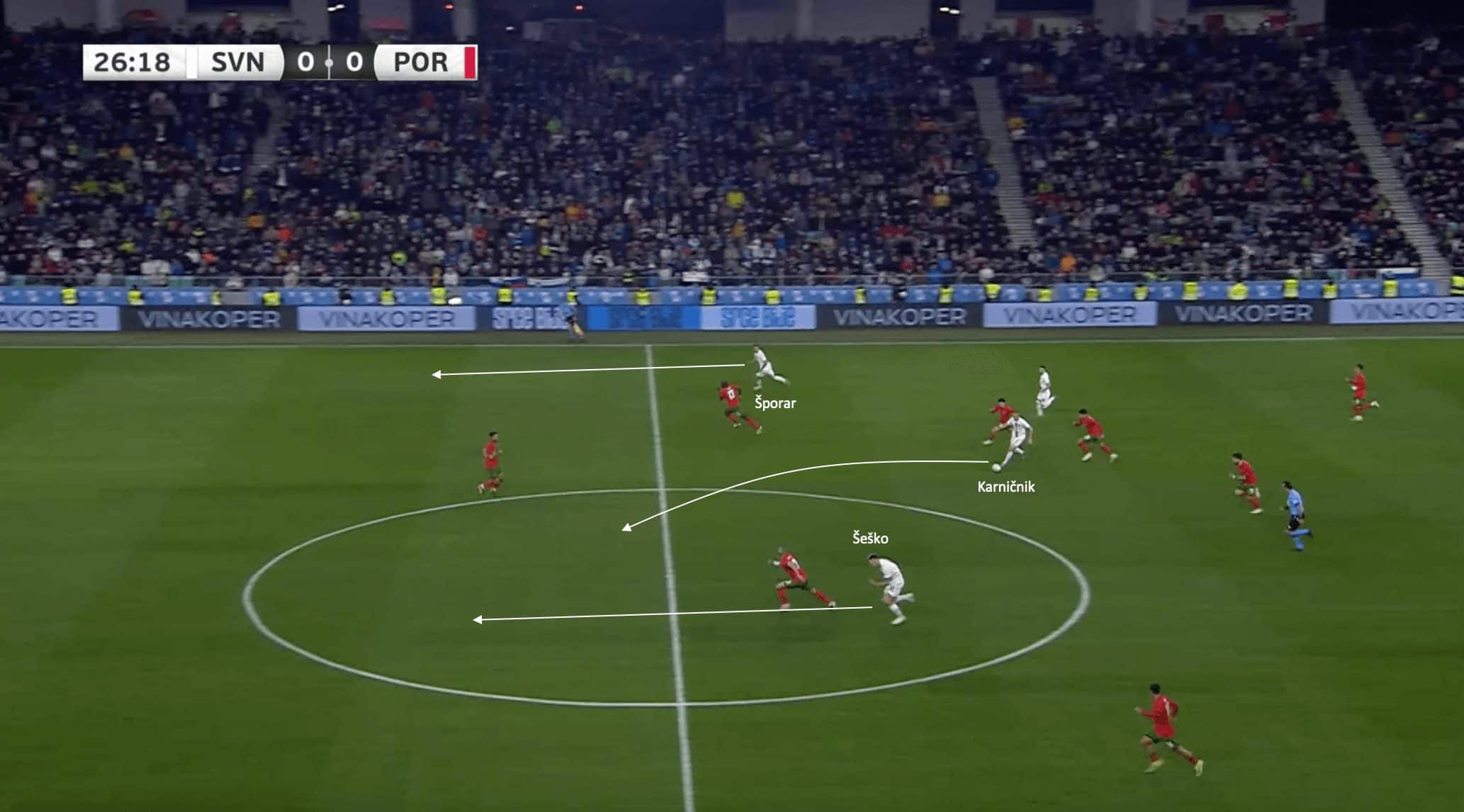
Another transitional moment for Slovenia is shown above, from their recent 2-0 friendly victory over Portugal.
This transitional moment resulted from some compact low-block defending from the home side, with right-back Karničnik able to win possession on the edge of the 18-yard box before driving centrally into midfield.
Further advanced up the pitch, Slovenian strikers Šeško and Šporar stayed advanced, looking to be outlets for fastbreak counterattacks.
Both strikers peel away from each other when making their runs, stretching the Portuguese defence while pinning them back and preventing them from stepping into midfield to close the space.
This allows Karničnik to continue driving into the midfield before attempting a pass into the path of Šeško, which, unfortunately, is intercepted by the Portuguese centre-back.
With Slovenia being in a relatively tough group, they may be forced to become more of a transitional side then they are normally used to being.
However, if that were to become the case, they would have plenty of threats in transition and may need to use their transitional moments clinically to punish sides on the break and create goalscoring chances.
Forwards
While it may seem pretty obvious, the key roles of the forwards for Slovenia this tournament are to put the ball into the back of the net.
With Slovenia placed in a group with England, Denmark, and Serbia, Kek’s side will need to score plenty of goals if they are to have a chance to qualify out of their group.
Luckily for Kek, he has a few forwards in his side who have been able to put the ball in the back of the net pretty often at club level this season.
Starting with Benjamin Šeško, the 20-year-old has been having a great debut campaign in Germany with RB Leipzig, with 17 goals in all competitions this season for Marco Rose’s side.
Šeško has also been able to find himself in great goalscoring positions, with the 20-year-old averaging 2.68 shots per 90 minutes and 56.3% of them being on target.
It is not just Šeško that Kek will hope can carry over their club form in front of goal to the international stage.
Šeško’s likely partner up top, Šporar, has also been in good form at club level this season.
The 30-year-old has scored 13 goals in all competitions for Panathinaikos this season while averaging 2.15 shots on target per 90 minutes and 57.1% being on target.
It is not just the likely starting forwards that have been able to put the ball in the net this season, with Vipotnik scoring 10 goals for Bordeaux this season, Žugelj having a good start to the campaign in Norway with three goals in his first seven appearances, and Celar scoring 19 with Lugano this season.
If Slovenia are to have a successful tournament in their group, they are going to need their forwards to continue scoring into the summer months.
Midfielders
To bounce off the previous section highlighting the forwards for Slovenia, ball progression will be key if they are to get the ball into the final third and into dangerous areas for their forwards.
The central midfielders will be the most responsible for linking the game and building through the lines, with Slovenia possessing some players who excel at ball progression.
Olimpija Ljubljana midfielder Timi Elšnik has an 84.4% pass completion rate this season while also being one of the most impactful midfielders in Slovenia in regards to chance creation this season with 11 goal contributions.
His likely partner in midfield, Adam Čerin, has a 90.6% pass completion rate in the Greek Super League this season, with a lot of these passes also being progressive.
The 24-year-old has made 160 passes into the final third this season for Panathinaikos.
Sturm Graz’s Jon Gorenc-Stanković is also likely to play a crucial part for Slovenia in the central midfield areas, with the 28-year-old playing 230 passes into the final third but still displaying a respectable 77.2% pass completion percentage.
Talking quickly about the wide midfielders for Slovenia, they will also need to be sharp on the ball in the final third, with Kek looking for the wide midfielders to stay high and push wide to look and stretch opposition defences.
While Jan Mlakar brings a more attacking mindset to Slovenia, Petar Stojanović on the right side of midfield will play more defensively at times, with the 28-year-old normally a right-back at club level for Sampdoria.
These two will have crucial roles in progressing the ball into the penalty area from these wide areas, with Slovenia looking to focus a lot of their attacks down the flanks.
Mlakar has averaged 2.07 touches in the penalty area per 90 minutes for Pisa this season in Serie B, while Stojanović has only 1.11 touches per 90 in the penalty area for Sampdoria, but playing as a right-sided defender.
Defenders
With Matjaž Kek looking to occasionally possess the ball for an extended period of time when starting with the goalkeeper, the central defenders and full-backs need to be adept at passing the ball.
Erik Janža has a 79.6% pass completion rate, Jaka Bijol sits at an 86.5% pass completion rate, Miha Blažić possesses one of the highest pass completion rates in the Ekstraklasa at 93.5%, and Žan Karničnik has an 83% pass completion rate while also attempting about 53 passes per 90 minutes.
They also, of course, need to be good from a defensive standpoint, and Slovenia will likely be under pressure often in their matches this tournament.
Karničnik has won about 60% of his defensive duels this season for Celje, Blažić has won 69.6% of his defensive duels, Janža has won 61%, and Jaka Bijol has won about 70% of his defensive duels for Serie A side Udinese.
If Slovenia are to perform well from a defensive standpoint, these players will need to be very good against the high-quality attackers they will face throughout the group stage.
Key player
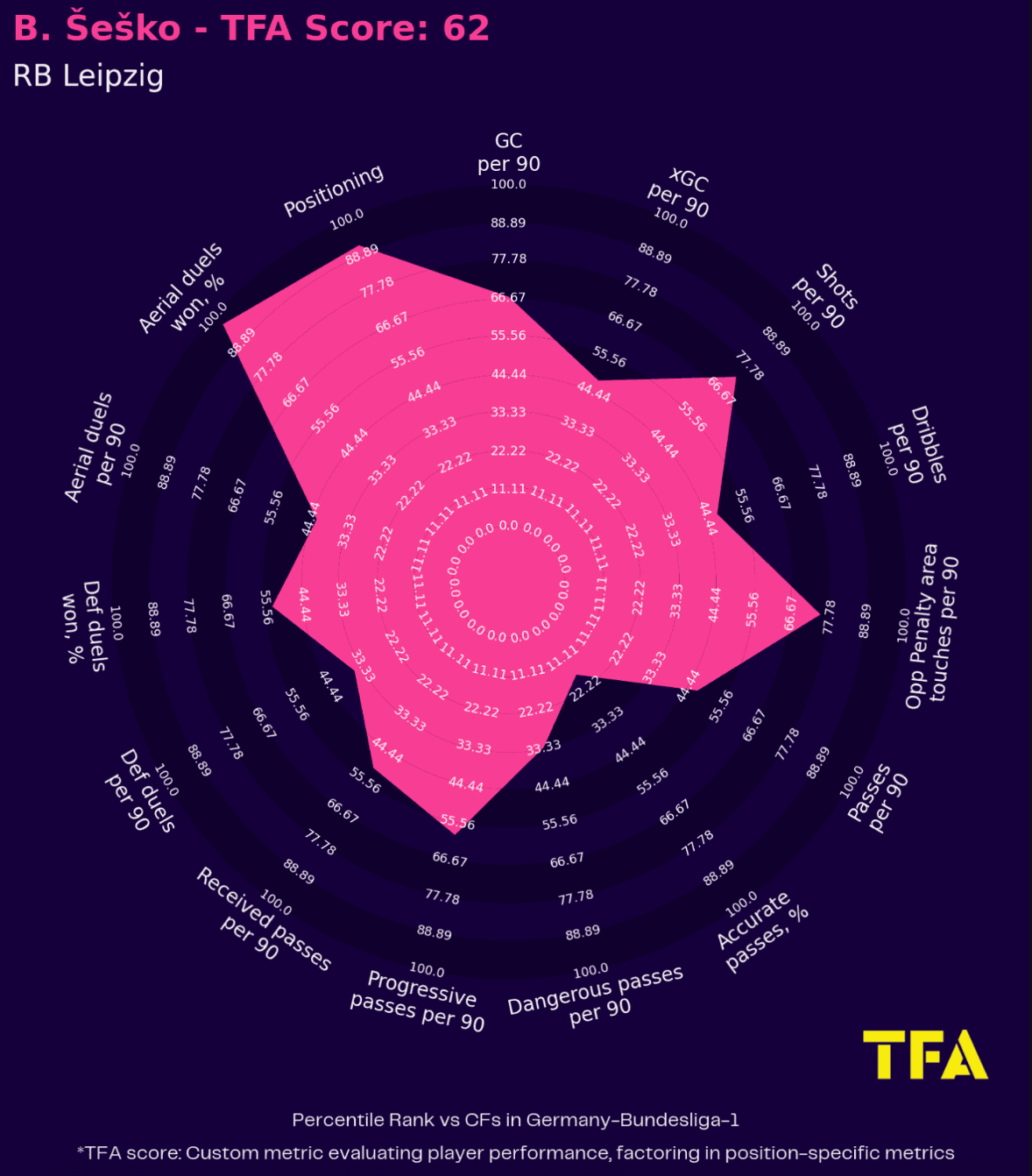
When looking at the squad Matjaž Kek will likely be taking to the European Championships this summer; it is hard to look past Benjamin Šeško as Slovenia’s key player for the tournament.
The 20-year-old has had a very good debut season for RB Leipzig in the Bundesliga since moving from Austrian side RB Salzburg last summer.
His 17 goals in all competitions for Marco Rose’s side has made him one of the most impactful strikers in Germany, and Kek will be relying on him to score goals for Slovenia this summer.
Looking at the radar graphic above, which compares Šeško’s metrics to other centre-forwards in the Bundesliga for this campaign, we can see that he is above the 90th percentile in both aerial duels won & and positioning, illustrating his threat in the air, as well as his ability to find himself in good goalscoring positions around the penalty area.
The Slovenian striker is not the greatest ball distributor, as we can see with his low percentile ranking for accurate passing percentage.
However, he does take plenty of touches in the penalty box per 90 minutes, with him needing to make these touches count to help Slovenia’s chances of progressing past the group stages.
Tournament prediction
On paper, Slovenia is likely the fourth-best team in their group, and it will be tough for them to overcome England, Denmark, and Serbia.
Slovenia’s highest group-stage finish at an international tournament was third at the 2010 FIFA World Cup, and they were never able to progress out of their groups.
For them to buck this trend, they are going to need to be at their best.

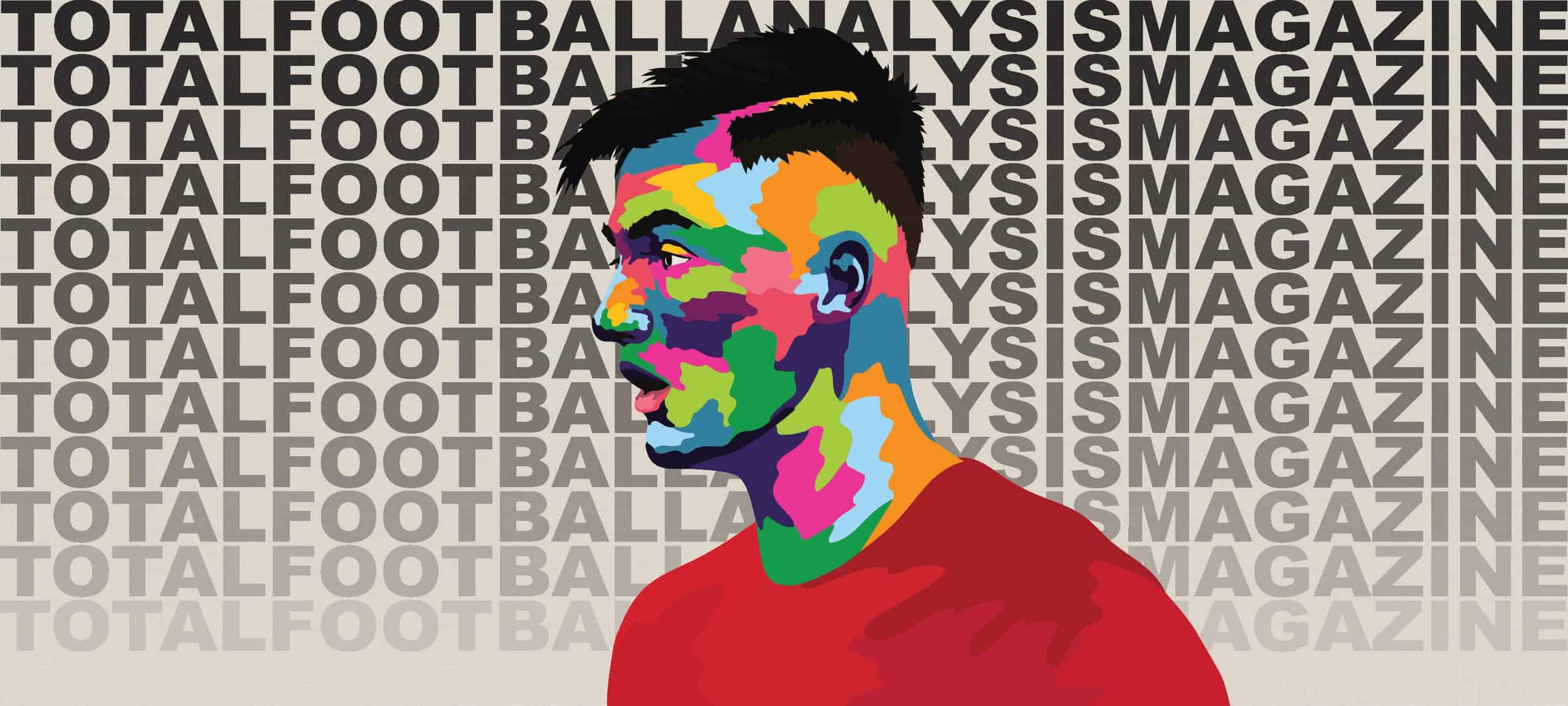



Comments